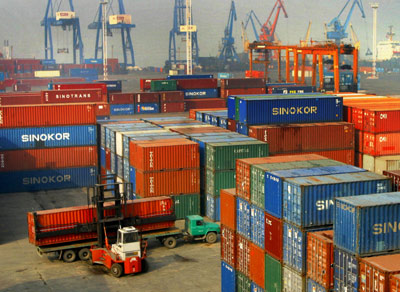|
China's economy grew 9.9% to US$2.3 trillion
By Xu Binglan (China Daily)
Updated: 2006-01-26 06:23
China's economy expanded by 9.9 percent in 2005, buoyed by strong domestic
demand that economists believe would continue to drive dynamic growth this year.

A port in Nanjing
is seen in this photo taken in January 11, 2006.
[newsphoto] |
The National Bureau of Statistics (NBS) announced wednesday that the country
produced an output of 18.23 trillion yuan (US$2.3 trillion) last year, or a
per-capita gross domestic product (GDP) of US$1,700.
Economists' predicted growth figure for 2006 varied from 8.5 percent to more
than 10 percent. But they agreed the economy is riding momentum and will
continue to be vibrant this year.
The adjustments that the government initiated in 2004 continued to suppress
activity in overheated sectors such as the steel industry last year. However,
investments in other sectors remained robust, said NBS Director Li Deshui.
Growth in consumption and exports were also respectable, he said.
"All three main drivers for the economy (investments, consumption and net
exports) were in good shape," he said at a press conference hosted by the State
Information Office. "The economy is full of vitality."
Economists agreed that overall domestic demand has been favourable and is
improving.
A research note released Wednesday by a group of economists at Goldman Sachs
said they believed the GDP grew last year partly because of domestic demand.
It was the third year that China's economic growth rate was around 10
percent.
It grew 10 in 2003 and 10.1 percent in 2004.
The rates were much higher than those of most other economies in the world.
But China's rates were still quite close to what economists call potential
growth of the country, which means a growth pace that can be maintained without
running into macroeconomic problems such as high inflation, according to Louis
Kuijs, senior economist at the World Bank's Beijing office.
He said China's potential growth in recent years has been between 9 and 10.5
percent.
"Thus, from this perspective, (China's) growth (rate) was appropriate not too
low, not too high."
Quarterly GDP growth rates for all of 2005 were more balanced than in
previous years, which indicated economic growth was becoming increasingly
stable, said Niu Li, an economist with the State Information Centre.
Rates for the four quarters were between 9.8 percent and 10.1 percent. In
previous years, fluctuations could be 1 percentage point or even bigger.
"This means that the intrinsic power of the economy mainly market forces
instead of factors outside the economy was having a greater influence, which was
a good thing," Niu said.
Another encouraging development in last year's economic performance was the
decline in oil consumption and oil exports.
In 2004, China's consumption of crude and refined oil grew 15.3 percent
compared with 2003. The net import (import minus export) figure jumped by 41.5
per cent.
In 2005, the consumption rate dropped 0.5 percent and the net import 5.3
percent compared with 2004. "This dramatic change indicated we are able to
maintain rapid growth while reducing consumption of energy and other resources,"
Li said.
However, the economic picture is not completely rosy.
Consumption still had a relatively weak effect on domestic demand, which is
an undesirable scenario, economists said.
Investments, which cover mainly building and upgrading infrastructure, plants
and apartments, contributed 48.8 percent of the 2005 GDP growth. Consumption,
which the government has been trying hard to stimulate, accounted for 33.3
percent. The remaining 17.9 percent was from trade.
|